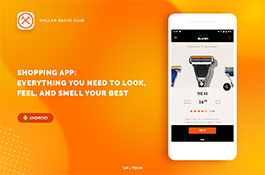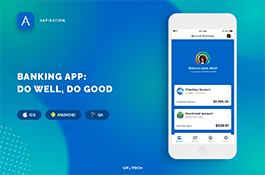Uptech is an international software development company that helps build profitable products with product market fit for companies on Fortune 500, Inc. 5000 lists and fast scale-up teams for technology startups. Our customer-centric approach to app development and industry know-how results in our client’s remarkable growth and our long-term partnership.
What apps we create:
- Native iOS and Android apps
- Cross-platform mobile apps (using Flutter)
- Web apps
By working with us, you not only get a 5-star product. You get smooth communication, full support, and openness. Why? Uptech is fully transparent and honest. This lets our team work like one organism and deliver service beyond expectation.
Our expertise:
- Healthcare
- Fintech
- E-commerce
- Proptech
- On-demand apps (like Uber)
- Streaming apps (like HQ Trivia)
To know the price and duration of development, contact us at [email protected]. We’ll specify the features of your app and provide you a full time&cost estimate.
Let’s make your idea real!
Focus Areas
Service Focus
- Mobile App Development
- Web Development
- App Designing (UI/UX)
- Web Designing (UI/UX)
- IT Services
Client Focus
- Small Business
- Medium Business
Industry Focus
- Consumer Products
- Healthcare & Medical
- Financial & Payments
Uptech Executive Interview

We are blessed to have a lot of repeat customers. In fact, 80% of our new projects come from the referrals of the existing ones. This is a good metric that signifies how our clients are satisfied with our services.
• What are your business goals and the expected roadmap?
• Who is your target audience?
• What are the Jobs-to-be-Done of our target audience (or their needs)?
• How will the product solve those needs?
• How do you know that you have a Product/Market fit? If not, what minimal effort can we do to validate/invalidate it?
• How do we plan to reach that audience?
• What is the budget?
• What are the business/user/market/privacy/legal constraints we need to take into account?
• What is the desired timeline for the project?
For the less-known brands that are just starting, it might be okay to start with one platform or to start with the cross-platform solution (React Native or Flutter) for the MVP. And migrate to the native solution once they get traction.
In general, we see that the user expectations increase and the quick MVP with minimal functionality is not good enough to start. Thus it’s better to launch on one platform with a good MVP, rather than on both platforms with buggy MVP.
• The number of features in the app.
• The UX requirements of the product (how smooth/fast the app should work).
• The complexity/quality of the design.
• Offline/online support.
• Types of some specific features/technologies involved (audio/video processing, location-heavy features, video streaming, AI, VR, etc.)
• Edge cases handling.
• Screen orientation support.
• How many different types of devices do we need to support?
and many many more.
The second model — Fixed-price project. It requires more planning up-front but allows the client to make sure the project would fit within the limited budget.
Usually, we start with the client with the Fixed-price project for the first MVP version and then move to the Dedicated Team model for the next releases.
Uptech Clients & Portfolios
Key Clients
- GOAT
- Aspiration
- Dollar Shave Club
- Yaza
- Cardless

 1 (1).jpg)










Uptech Reviews
- All Services
- Mobile App Development
- App Designing (UI/UX)
- Relevance
- Most Recent
- Rating: high to low
- Rating: low to high

Top notch team with a rigorous process able to take on challenging projects.
Review Summary
There were some initial performance issues, but those were addressed over time. The app was launched targeting travel use cases just a few months before covid started. Uptech worked with us to help us reposition the app for other use cases to help the company survive. That burned more money than we had budgeted, but Uptech allowed us to pay it over time. The only thing I didn’t like is that when it became clear our money was low, they passed us on to another firm who were not so great. In the end we were able to raise more money and it would have been much better for us if they had stuck with us.
What was the project name that you have worked with Uptech?
Yaza video mapping and sharing
What service was provided as part of the project?
Mobile App Development, App Designing (UI/UX)
Describe your project in brief
An iOS app for travelers to map and share their experiences with short videos that can be shared as links that play with a map in web browsers.
What is it about the company that you appreciate the most?
The people there are great. Talented, smart, and able to take on challenging projects.
The have adopted the latest lean startup practices. It feels very much like working with a firm straight out of Silicon Valley
What was it about the company that you didn't like which they should do better?
I didn’t like being dumped when we were between rounds and low on cash.
Although they discounted billing to address some of the performance issues, It was a bit of a battle to get there.
Their bottleneck was having two few UX/UI designers in house, but perhaps that has been addressed with more hires.

The best team I had worked with so far
Review Summary
One of the best development company I had worked with and I highly recommend them to anyone who cares about his product :).
What service was provided as part of the project?
Mobile App Development

Srsly, these guys are the best, that is really all that needs to be said
Review Summary
What service was provided as part of the project?
Mobile App Development
What is it about the company that you appreciate the most?
They suggest improvements over my original scope.
What was it about the company that you didn't like which they should do better?
The only area we could improve is the task management. I'm sorta a PT guy and they like Trello (not a huge fan). But we manage and we're improving.

Amazing Team and Expertise
Review Summary
What service was provided as part of the project?
Mobile App Development, App Designing (UI/UX)

Best of the best
Review Summary
What service was provided as part of the project?
Mobile App Development, App Designing (UI/UX)














































